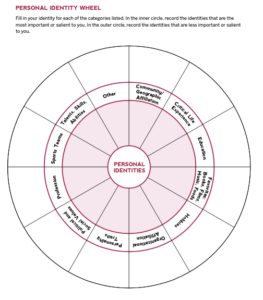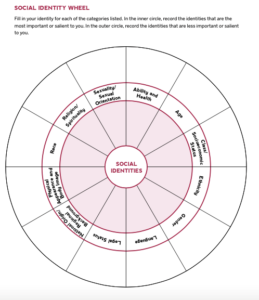Identity in Health Professions Education
Vicki Hayes, MD
MMC Dept. of Medical Education
Master Educator, The Academy at MITE
Learning objectives:
- Define identity
- Explore your own identity and how it might vary in different contexts
- Reflect on how identity might be utilized in an educational setting
Defining identity:
In the context of DEI, identity is an individual’s multidimensional sense of self, developed over time, and influenced by interpersonal and collective factors. It is a sense of who you are, the way you think about yourself, the way you are viewed by the world and the characteristics that define you. It is multi-faceted and fluid–it can change over time and vary in different situations.
Key Points:
- Identity matters because we must first understand ourselves and our own identity before we can appreciate others’.
- Exploring our identity helps us to understand how we interact with and present ourselves to others, where we “lead from”.
- There may be elements of our identity that we don’t pay attention to or take for granted. We need to be aware of those elements in order to recognize our privilege.
Exploring your own identity:
How would you introduce yourself in a social situation? (Hi, I’m Vicki. I’m married to Tim and have three grown children). How might that differ in a professional setting? (Hi, I’m Vicki Hayes. I’m a family medicine physician with a specialty in adolescent medicine…or a journal associate editor…or a medical school course director). What attributes would you use to describe yourself?
An identity wheel can help us think about how we identify. Everyone has a personal and a social identity. Personal identities include a person’s name, unique characteristics, history, personality and other traits that make a person unique. Social identity includes affinities one has with other people, values and norms that one accepts, and the way one has learned to behave in social settings.
Look at these identity wheels and think about how you might fill them in for yourself:


Key points:
- What aspects did you choose as most important to you and why? (I would choose profession, community/geographic affiliation and critical life experience. My upbringing in an oppressive Southern household combined with my pursuit of advanced education have shaped how I personally identify and present myself to the world.)
- What aspects were less important to you or not important at all? Were there any that you really haven’t considered previously at all–why do you think that is? (I rarely, if ever, consider religion, race, ability or sexual orientation when considering my social identity.)
- Think about how these aspects of identity might affect how you behave or present yourself to others.
- Do you have aspects of your identity that you feel are often overlooked, under-appreciated or not understood by others?
- And now think about a time when some aspect of your identity felt threatened–perhaps by a negative comment. (Aspects of my identity, such as age and appearance, have changed over time. Negative comments about aging and ability in medicine threaten my perceptions of my personal competence.)
- How might this exercise help you to consider others’ identities?
Identity in educational settings:
- First, be aware of your own identities. A self-aware teacher is better able to support and empower learners.
- Recognize and consider vocalizing how your identity might have an impact on your interpretation and presentation of a topic. (As an adolescent medicine specialist, I lecture on the care of LGBTQ patients. As a cis-gender, heterosexual female, I recognize that my knowledge on this topic has come primarily from my professional work and not from my lived experience. It is important that I acknowledge and share that information.)
- Set a welcoming, inclusive tone for your learners. A positive learning climate will enhance the students’ ability to assimilate knowledge.
- Be a role model.
- Demonstrate that you have explored your own identities and are aware of privilege.
- Share your identities to the extent that feels appropriate and you are comfortable. (Share personal pronouns on virtual platforms such as Zoom or on ID badges, at the start of presentations.)
- Look for and acknowledge others’ identities.
- Acknowledge times when your identities might affect your educational role.
- Be a mentor.
- Students may perform better academically and have an enhanced sense of belonging when elements of their identity are similar to a teacher or mentor’s (such as race, sexual orientation or background).
- Facilitate students’ ability to connect with you. Consider making demographic, self-reported identity and allyship information available to learners. (In an orientation presentation to new medical students about my pathway to medicine, I revealed that I had been the victim of interpersonal violence. Several students reached out later to share their stories and how they were inspired by mine.)
- Helping students integrate their professional identity with their other identities is foundational within a health professions education.
References:
- https://www.ncedsv.org/wp-content/uploads/2017/07/Engaging-Millennials-and-Prevention-Education-_In-Reach_-Strategies-Carmella-Gadsen.pdf
- https://www.ccl.org/articles/leading-effectively-articles/understand-social-identity-to-lead-in-a-changing-world/
- Goldie J. The formation of professional identity in medical students: Considerations for educators. Med Teach. 2012;34(9):e641-e648. DOI: 10.3109/0142159X.2012.687476
- Kaundinya T. Facilitating Identity Compatibility in Mentorships: Implications for Diversity in Medicine. J Med Educ Curric. 2021;8:1-2. DOI: 10.1177/23821205211006412
